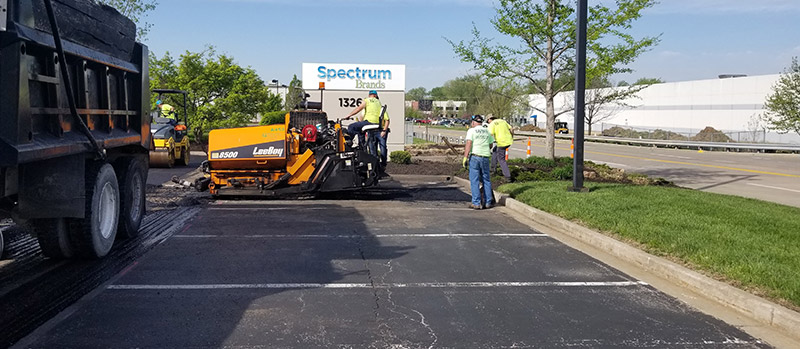What Does A1 Professional Asphalt & Sealing Llc Do?
What Does A1 Professional Asphalt & Sealing Llc Do?
Blog Article
9 Simple Techniques For A1 Professional Asphalt & Sealing Llc
Table of ContentsThe Buzz on A1 Professional Asphalt & Sealing LlcAll about A1 Professional Asphalt & Sealing LlcTop Guidelines Of A1 Professional Asphalt & Sealing LlcThe Greatest Guide To A1 Professional Asphalt & Sealing LlcTop Guidelines Of A1 Professional Asphalt & Sealing Llc

The oil in an auto engine is not simply oil. It has a variety of additives to improve the lorry's performance. These consist of polymers, viscosity modifiers, warmth stabilizers, extra lubricants, and put on additives. The REOB includes all the additives that were in the waste oil in addition to the wear metals from the engine (mainly iron and copper).
Nonetheless, by making many blends utilizing various REOB examples and various asphalt binders, the variations mainly can be averaged out. Numerous States offered examples of well-known REOB structure to TFHRC scientists, that analyzed the examples to compare the percentage of added (understood) REOB to the discovered (checked) amount. The evaluations showed a comparable percentage of added and found REOB.
Not known Details About A1 Professional Asphalt & Sealing Llc
None of those States recognized that the asphalt they were purchasing contained REOB. One State urged its examples had no REOB - https://www.webtoolhub.com/profile.aspx?user=42388970.
Of the 1,532 examples examined, 12 percent had REOB, and some had significantly high degrees of it at 1020 percent. The greatest level was 34 percent in an example from Texas, which TxDOT had used in a patching substance. This screening additionally exposed the visibility of phosphoric acid in 11 percent of the examples, and 2 percent contained ground tire rubber.
2 years back at TRB's annual conference, the Federal scientists held an REOB workshop and offered the searchings for of their research laboratory evaluations to a standing room-only group. Some companies do not especially prohibit REOB, they do enforce physical tests that avert its useeffectively a ban. Others do not ban it by requirements, yet have contracts with asphalt vendors to stay clear of using REOB
Rumored Buzz on A1 Professional Asphalt & Sealing Llc
A handful do enable REOB, some within certain limitations. Ohio and Texas limitation degrees to much less than 5 percent of the asphalt. To create a reputable examination approach that all States can make use of, the TFHRC researchers set up a round-robin test strategy. The participants are 11 State freeway firms (Illinois, Massachusetts, Minnesota, Mississippi, Montana, North Carolina, Oklahoma, South Carolina, Texas, Vermont, and Wyoming), 2 independent testing labs, the Ministry of Transportation in Ontario, Queen's University in Ontario, and an Ontario paving specialist.
The participants are testing the samples individually utilizing the guidelines offered by the TFHRC researchers. The result will be a recommended AASHTO examination technique that any State can adopt and make use of.
The pavement with REOB, which is located 0.6 mile (1 kilometer) from the sidewalk without REOB, has similar subgrade, traffic thickness, and climate. The sector of Highway655 with 5 to 10 percent REOB showed significant breaking. In this example, the presence of REOB was the determined cause of breaking at a low temperature levels.
"In our experience in copyright, even tiny quantities of 23 percent can be an issue." Similarly, an area of test sidewalk in Minnesota (MN1-4) discovered to contain REOB also split too soon. The pavement executed well for the first 3 to 4 years, however after that started to split. This sidewalk is also based on reduced temperatures.
A1 Professional Asphalt & Sealing Llc - Questions
The tests were not comprehensive, however they revealed that at levels of 6 percent or even more, the tensile stamina of the asphalt went down significantly. At a level of 3.5 percent REOB, the variation in the physical examination approaches was more than the result of REOB. It was difficult for scientists to analyze whether REOB was present. https://slides.com/a1asphaltseal.

One binder specification considered is the distinction in between the low temperature level critical specification temperature level for stiffness (S) in the bending beam of light rheometer and the bending light beam rheometer creep slope (m-value) noted as Tcritical. TC = TC (S) TC (m-value). Analysis of this parameter is still continuous. Two independent study groups, one from AASHTO and the various other from the Asphalt Institute, wrapped up that more study is required on using REOB in asphalt.
Previously, all asphalt screening measured design properties such as rigidity. These tests do not show what products had been included to the asphalt.

Get This Report about A1 Professional Asphalt & Sealing Llc
These results demonstrate there are weak points in the standard design testing procedures that may be made use of. The manufacturer might have a financial advantage and the product passes all the standardized examinations, yet the item might not be beneficial to guaranteeing long-term performance. To resolve this concern and check here the expansion of new asphalt additives and extenders, TFHRC is starting a research program to utilize handheld spectroscopic tools, x-ray fluorescence spectroscopy, and Fourier change infrared spectroscopy to make it possible for evaluations to be performed in the field instead than needing to take samples back to the laboratory.
Report this page